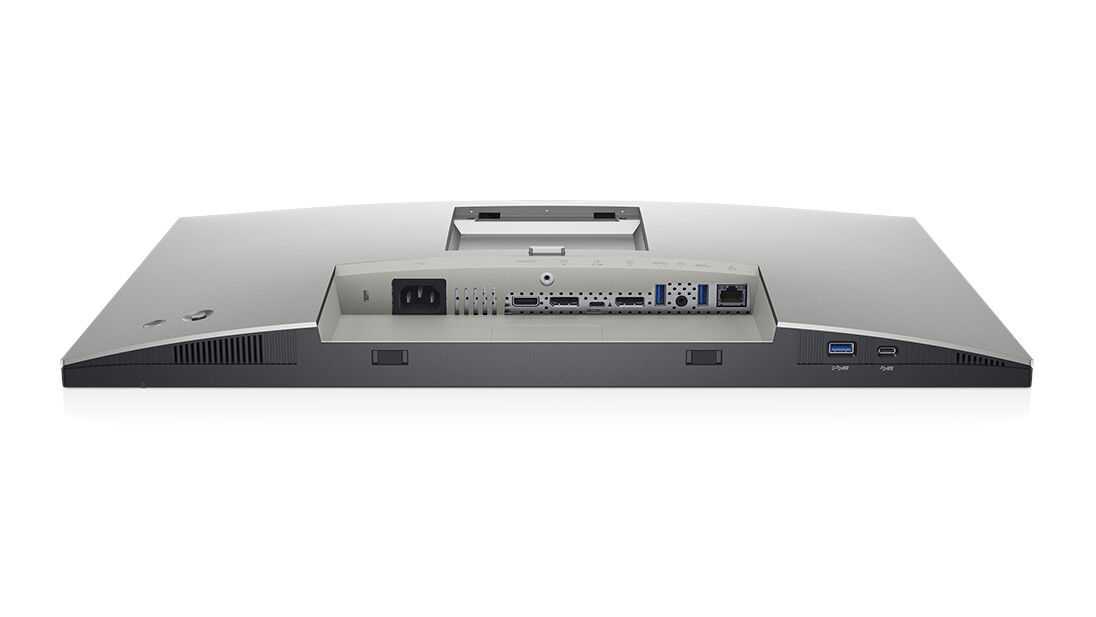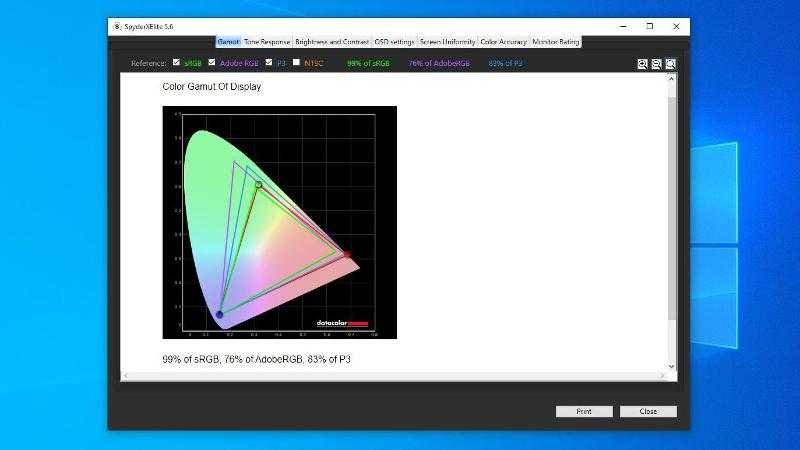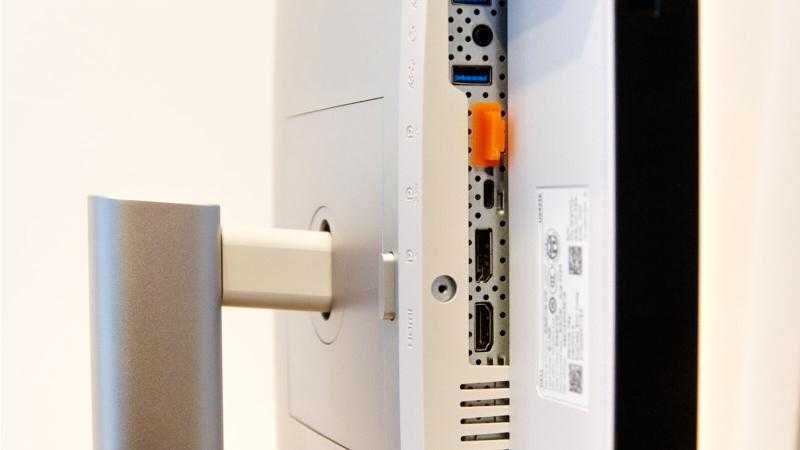Out of the box
Dell deserves a gold star for the packaging alone. The tray that holds the U2421E, its support arm and all the cables uses pressure-formed cardboard and not that horrible, expanded foam so beloved by many monitor makers.
Not only is this better for the environment, but this option doesn’t coat the display with excessive amounts of static electricity that then attract all the dust from the room within hours.

Along with the display, you get a two part-support arm that can be assembled and attached to the screen without tools and a good selection of cables.
Gone is the era where an included HDMI cable impressed us, but then that isn’t included. What is are a DisplayPort cable, a Type-A to Type-C USB and a dual-ended USB Type-C cable.
There were also two power cords in my box, one for the US and one for the UK. Dell is usually very attuned to local socket differences, so I would expect at least one power cord that fits the outlets in your home or office.
Getting the U2421E out of the box and assembled is remarkably easy, as the panel only weighs 4kg, and joining it to the support is a tool-free operation.
The support arm and base are both plastic covered but have metal internal parts making them sturdy enough to support the display. They also provide plenty of adjustment with 21 degrees of tilt backwards and 5 degrees forward, 40 degrees of swivel and 90 of pivot. The pivot, or twist if you prefer that word, is combined with 15cm of vertical travel that enables the U2421E to be used for portrait mode.
Other aspects of this design that I like include an internal PSU, avoiding the annoying proprietary power brick that is usually the first point of failure. Dell also resisted the urge to put a cover over the inputs, making cabling remarkably easy if you use the pivoting feature to improve access.
Specs
Dell Ultrasharp U2421E: Specs
- Model No.: U2421E
- Panel Size: 24.1in (61.13cm)
- Resolution: 1920 x 1200
- Display Technology: IPS
- Aspect Ratio: 16:10
- Response Time (GtG): 8ms normal, 5ms fast
- Viewing Angle: 178°(H)/178°(V)
- Maximum Refresh: 60Hz
- HDR: N/A
- Video Ports: 1x HDMI 1.4, 1x DisplayPort 1.4, 1x USB Type-C (Alternate mode with DisplayPort 1.4, USB 3.2 Gen1 upstream port, Power delivery up to 90W4), 1 x DP (Out) with MST
- USB ports: 1x USB Type-C downstream (15W), USB 3.2 Gen1 (5 Gbps), 2x SuperSpeed USB 5 Gbps (USB 3.2 Gen1), 1x SuperSpeed USB 5 Gbps (USB 3.2 Gen1) with BC1.2 charging capability at 2A (max)
- Other Ports: 1x Analog 2.0 audio line out (3.5mm jack), 1x RJ45
- Webcam: N/A
- Typical Brightness: 350 nits
- Static Contrast: 1000:1
- Variable Sync: N/A
- Weight: 6.1kg (with stand), 4kg (without stand)
- Warranty: 3 years
You should not buy this if …
- You want a 24-inch full HD monitor for a desktop PC
- You need higher resolution and color accuracy for media work
Let’s be clear, while the pricing of the Dell UltraSharp U2421E is not cheap for a full HD experience you are buying this because it is both a solid productivity display and the all-in-one laptop hub feature for a single-cord experience. The Dell UltraSharp U2421E is perfect for those who use one laptop for work and want to have a bigger display experience with a Type-C wire. If you only need a 24-inch full HD monitor for a desktop PC, this is overkill.
Image 1 of 2
The build quality, port options, and flexibility in the stand (including the ability to rotate to vertical orientation) deliver a unique offering in a crowded market of budget and work-related displays.
While the Dell UltraSharp U2421E is not for everyone, if you are looking for a larger screen for your laptop along with a full hub-experience, this is an excellent option without going ultrawide.
(opens in new tab)
Dell UltraSharp U2421E
Bottom line: Dell’s 16:10 UltraSharp U2421E is not just another 24-inch monitor but also a perfect solution for heavy laptop users who want a larger desktop experience. The price is a bit high, but the color-accurate display and slick, minimalist design would look great in any home office or workspace cubicle.
Don’t buy it if…
You’re looking to buy a gaming specific monitorThis monitor has an input response time of 8ms and a maximum refresh rate of 76Hz. While this isn’t horrible for gaming, there are much better displays out there for the same price or even cheaper.
Your graphics card doesn’t support DisplayPort connectionsThe monitor has an HDMI input for connecting to older graphics cards, but you’ll get the most out of the screen if you use a DisplayPort connection; it allows for 4K video and graphics as well as higher refresh rates for smoother playback.
You don’t have space for external speakersThis monitor doesn’t have any integrated speakers, though it does have a headphone jack for private listening. If you’re an audio engineer or prefer not to use a headset, you may want to look at other monitors.
Dell UltraSharp U2421E: What I don’t like
Source: Daniel Rubino / Windows Central (Image credit: Source: Daniel Rubino / Windows Central)
The 1920 x 1200 (WUXGA) resolution at 24-inches is excellent for writing in Word, browsing the web, and more. Still, it is also on the low end than modern «2K» options that deliver more pixels per inch for media consumption.
Pricing is also a bit high even when on sale for $375 (MSRP is $450). By comparison, the Dell 27-inch 4K UHD S2721QS is the same $375 and comes with AMD FreeSync and supports HDR – both of which are missing on the U2421E. Of course, the 4K S2721QS also lacks that Type-C 90-watt hub, Ethernet, and omits any Type-A ports, where the differences manifest.
While the Dell UltraSharp U2421E is perfect for laptop users, you cannot split the screen with two inputs. That’s probably OK due to the aspect and resolution, but we see a feature pop up in . See our for more ideas if you need something a bit larger or with more features.
Performance
Dell very kindly includes a factory generated colour calibration report in the box, showing how the monitor performed before it was shipped.
My sample had three graphics that covered sRGB Delta E over the spectrum, Gray-Scale tracking of colour temperature and finally Gamma against brightness per cd/m2 (nits).
What is odd is that on Dell’s graph, the U2421E failed to reach the 350 nits quoted on the specifications. Not that makers don’t exaggerate about their products, but in my testing this design not only reached that level but exceeded it.
Peak brightness was 365 cd/m2, above the quoted 350cm/m2, and static contrast was 980:1, just a tiny bit short of the 1000:1 that Dell quotes. The uniformity of brightness is also good, with an average deviation of less than 4% from the centre, although for whatever reason, it is noticeably darker in the middle top.
However, when you push the brightness up from the 75% default setting on the OSD, you are asked if you are sure you want to do that. If operating above this level is an issue, why provide the option to select it?
More positively, the colour representation is good, but not at a level that would impress those considered to be colourists. The screen managed 99% of sRGB and 83% of P3, but only 76% of the AdobeRGB gamut. The spectrum weakness is almost exclusively on the green side, with the blue and red scope being first-rate.

For a business-orientated panel, these are solid numbers and could sway some to spend more on this design for the high quality of the representation.
Verdict
The U2421E has strengths but also a few weaknesses.
On the plus side, it looks professional, and the support arm allows it to pivot and tilt extensively. It’s also got decent colour representation with close to 100% sRGB coverage and 83% of the P3 colour space.
The USB-C features are also a successful enhancement as they could easily remove an expensive USB-C docking station from a system purchasing budget. However, I can’t accept the notion that it makes economic sense to buy two of these and chain them via DisplayPort, even if it is technically possible.
It is possible to source an Ultrawide screen for less than the combined cost of two of these, and that hints at the significant problem the U2421E fails to confront, cost. A short surfing session on many large online retailers will reveal several similar designs with a remarkably close specification, and most are generally less expensive.
While it doesn’t need to match or better the very cheapest alternatives, it needs to be closer to them than it currently is to make this a worthwhile investment.
Features & Design
I’ve concluded that all monitors have the designer’s thinking embedded in them intrinsically. Presumably, as a start point, each is given an archetypal customer definition and the resulting product represents an answer to that problem.
The mystery is that we never get to see the brief and only guess what it included based on how the design ended up. At the heart of the question answered by the U2421E is laptop use, specifically those that use one for both mobile computing and in the office.
Therefore, an essential aspect of this design is its ‘hub’, which performs the same role as a
USB-C docking station.

Connecting requires a USB 3.2 Gen 2 USB-C port, ideally the charging port on the machine. With increasingly powerful laptops coming to market, offering 60W or even 85W might not be enough.
This one line can deliver 90W of power, enabling it to power the machine in use and charge the battery simultaneously.
But this connection also provides for downstream USB connections to peripherals, like a mouse and keyboard, another USB-C device with 15W of charging (a phone), RJ45 wired networking and can also carry the display data.
Via this single cable, the laptop is not only able to recharge but connected to everything it needs quickly and effectively, avoiding the need for a docking station or more complex wiring solutions.
But you can also connect any computers that have the most common video outputs. HDMI and DisplayPort are standard requirements and therefore expected, but the inclusion of DisplayPort out is an odd option that we don’t often see these days.
Dell makes a dual Monitor arm, the MDA20, that two U2421E might nicely fit. A single DisplayPort output can be connected to one and then chained to the second monitor via the DisplayPort out.
As neat a solution as that might be, it only works if the price of two U2421E is less than an ultrawide display that only has a single connection, has no frames dividing the middle of the image and doesn’t require a dual monitor arm.
Those economics don’t work, unfortunately, making this feature somewhat redundant.
Dell UltraSharp U2421E: What I like
Source: Daniel Rubino / Windows Central (Image credit: Source: Daniel Rubino / Windows Central)
There are two main reasons to get the Dell UltraSharp U2421E. One is the rare but welcomed 16:10 display aspect. Today, most monitors are 16:9, which is wider and better tuned if you watch movies or videos a lot. With 16:10, you get a taller aspect better suited for web browsing, Office productivity, and general work-related tasks. When combined with some razor-thin bezels, the U2421E looks slick in any office cubicle or home working area. Another bonus is if you use this monitor with the Dell , , or , you get a matching screen experience since those are all 16:10 too.
The other highlight of the Dell UltraSharp U2421E is the built-in hub feature. If you are a one-PC kind of person who only wants to use a laptop, this is your monitor. With a 90-watt Type-C plug, you can connect to any modern laptop for display out and charge your device simultaneously. There is a built-in RJ-45 Ethernet for wired internet, three Type-A ports, and you can daisy chain the DisplayPort to extra monitors if you are a real power user.
This monitor relies on Type-C and not the more advanced , so any modern laptop with a Type-C port, including Surface PCs, works just fine.
Image 1 of 2
Swipe to scroll horizontally
| Category | Dell UltraSharp U2421E |
|---|---|
| Size | 24 Inches |
| Resolution | 1920 x 1200 WUXGA |
| Aspect Ratio | 16:10 |
| Panel Technology | In-Plane Switching (IPS) |
| Refresh Rate | 60Hz |
| Response Time | 5ms |
| Contrast Ratio | 1000:1 (Static) |
| Brightness | 350 cd/m² |
| Blue light | Yes via ComfortView Plus |
| Connectivity | 1x DisplayPort 1.41x DP Out (MST)1x HDMI 1.41x USB-C 3.2 Gen1 (90w)1x USB-C 3.2 Gen1 (15w)3x USB 3.2 Gen11x Audio Jack1x RJ45 |
| Built-in Speakers | No |
| Stand | Height adjustabaleTiltPivot |
| VESA Compatibility | Yes 100 x 100 |
| Dimensions with Stand (WxHxD) | 20.9 x 14.33 x 6.81 inches |
| Weight | 8.8 lbs |
Color accuracy is also solid at 98 percent sRGB, 74 percent AdobeRGB and 75 percent DCI-P3. Those are not extraordinary levels of color precision, but they are more than good enough for basic photo editing or office work. Each Dell UltraSharp U2421E is also factory color calibrated, and the results are included in each box.
Brightness peaks around 350-nits, which is fine for indoor usage, and the anti-glare helps reduce eye fatigue from overhead office lighting. The 60 Hz 5ms response is good enough, so you do not see any ghosting when scrolling. There are ample 178 degrees of viewing without color shift thanks to IPS display tech.
Adjustments for the on-screen display (OSD) settings are accessed via a physical joystick, which is nice to have at this price level. Adjusting the monitor’s brightness and settings is a breeze.
Source: Daniel Rubino / Windows Central (Image credit: Source: Daniel Rubino / Windows Central)
Dell’s stand is also quite good with a quick attach feature, VESA support, tilt, rotate, and height-adjust if you want to go vertical or better target it for your line of sight.
A bit pricey

































